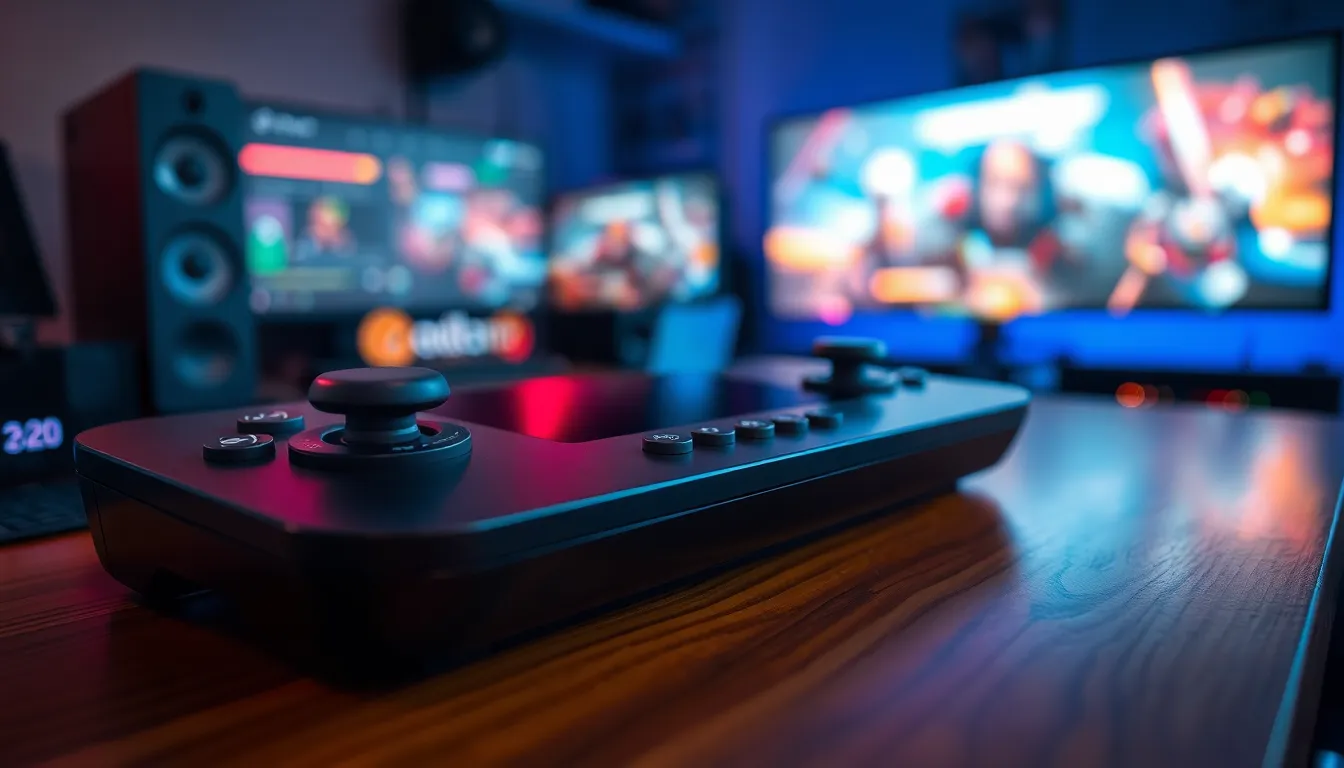The Steam Deck is the portable gaming device that’s taken the gaming world by storm, blending power and convenience in a way that makes even the most seasoned gamers giddy. Imagine cramming a gaming rig into your backpack, ready to unleash epic battles on the go. It’s like having a gaming PC that fits in your hands—no more waiting for the right moment to sit down at a desk.
But how does this little powerhouse actually perform? Spoiler alert: it doesn’t just play games; it plays them like a pro. From AAA titles to indie gems, the Steam Deck delivers an experience that’ll make you question if you really need that bulky desktop setup. Let’s dive into the nitty-gritty of its performance and see if it lives up to the hype—or if it’s just another overhyped gadget that’ll end up gathering dust.
Table of Contents
ToggleOverview of Steam Deck Performance
Steam Deck performance showcases its capabilities across various gaming genres. Equipped with a custom AMD APU, the device operates with a quad-core Zen 2 CPU and RDNA 2 GPU architecture, enabling efficient processing. Frame rates often exceed 60 FPS in less demanding titles, while AAA games can see performance ranging between 30 to 60 FPS, depending on graphics settings.
Graphics settings play a critical role in performance optimization. Lowering the resolution or adjusting detail settings significantly enhances frame rates in graphically intensive games. Players often report enjoyable experiences with titles like Elden Ring and Hades, indicating the device competently handles both high-end and indie games.
Battery life remains a vital aspect of performance. Users typically experience between 2 to 8 hours of gameplay, influenced primarily by game intensity and settings. A balance of performance settings allows for extended gaming sessions without constant recharging.
Cooling designs also affect performance. The Steam Deck incorporates a custom cooling system, which keeps temperatures manageable during extended play. This design maintains stability, ensuring that performance doesn’t throttle under heat.
Additionally, storage options influence load times and overall experience. With SSD storage, games load significantly faster compared to traditional HDDs, enhancing user experience. Gamers often appreciate the accessibility of expanding storage through microSD cards, adding flexibility.
Lastly, its Linux-based SteamOS supports a vast library of games, showcasing compatibility with numerous titles. The ability to install Windows further diversifies gaming options, appealing to a broader audience. Performance across this unique operating system proves robust, making the Steam Deck a versatile choice for mobile gaming.
Hardware Specifications

The Steam Deck packs impressive hardware into its portable design. This allows gamers to enjoy high-quality performance across various titles.
CPU and GPU Capabilities
The Steam Deck features a custom AMD APU, integrating a quad-core Zen 2 CPU and RDNA 2 GPU architecture. This setup supports high frame rates, often exceeding 60 FPS in less demanding games. AAA titles typically perform in the 30 to 60 FPS range, showcasing the device’s power. Users can optimize graphics settings to enhance their gameplay experience. Titles such as Elden Ring and Hades run smoothly, demonstrating the capability of the hardware.
RAM and Storage Considerations
Equipped with 16GB of LPDDR5 RAM, the Steam Deck ensures efficient multitasking and fast load times. Fast data transfer benefits players, especially when running demanding applications. Storage options include a speedy SSD, which greatly reduces load times compared to traditional hard drives. Users also have the choice of expanding storage via a microSD card, providing flexibility for game libraries. This combination of RAM and storage creates a solid foundation for seamless gaming experiences.
Gaming Performance
The Steam Deck provides an engaging gaming experience with impressive performance metrics. Gamers can expect it to handle a wide variety of titles smoothly.
Frame Rates and Resolution
Frame rates often exceed 60 FPS in less demanding games, ensuring a fluid experience. AAA titles like The Witcher 3 and Cyberpunk 2077 typically achieve 30 to 60 FPS based on graphics settings. Resolution plays a crucial role as well, with many users opting for a 720p display to optimize performance. Players adjusting graphics settings can further enhance frame rates, creating a more enjoyable gameplay experience. Reduced detail in visuals often leads to smoother performance, keeping gamers engaged for longer sessions.
Performance in Different Genres
Performance varies across gaming genres, with the Steam Deck excelling in both indie games and larger AAA releases. Action RPGs run exceptionally well, delivering immersive experiences that capture players’ attention. First-person shooters maintain responsiveness, allowing quick movements and precise aim. Strategy games benefit from the device’s efficient multitasking capabilities, enabling smooth navigation through complex interfaces. Sports titles also perform reliably, appealing to fans of fast-paced gameplay. By adjusting settings, gamers maximize the Steam Deck’s versatility across genres.
Comparison with Other Handheld Consoles
Noteworthy comparisons reveal how the Steam Deck stacks up against other handheld devices in the gaming market.
Nintendo Switch vs. Steam Deck
The Nintendo Switch offers unique features, targeting casual gamers and families. In contrast, the Steam Deck appeals to dedicated gamers seeking high performance. While the Switch operates on a custom NVIDIA Tegra X1 chip, the Steam Deck boasts a more powerful AMD APU with its quad-core Zen 2 CPU and RDNA 2 GPU. Frame rates highlight this disparity; the Steam Deck consistently achieves higher frame rates, often exceeding 60 FPS in various titles, while the Switch typically handles 30 FPS in demanding games. Storage options differ as well, with the Steam Deck supporting SSD and microSD expansion, compared to the Switch’s limited internal storage.
Mobile Gaming Devices
When examining mobile gaming devices, especially those like the AYN Odin and GPD Win 3, performance varies significantly. Both competitors present unique gaming experiences, but neither matches the Steam Deck’s power. Users typically appreciate the Steam Deck’s versatile gaming library and compatibility with PC titles. Additionally, its impressive battery life spans between 2 to 8 hours, depending on usage, making it a strong choice for on-the-go gaming. The Linux-based SteamOS supports a vast catalog of games, enhancing its appeal among dedicated gamers. Optimized graphics settings on the Steam Deck further enrich the gaming experience, especially for demanding titles.
Benchmarking Results
Performance evaluations reveal how well the Steam Deck excels during gaming. Various tests lend insight into its capabilities in both real-world scenarios and controlled environments.
Real-World Testing Scenarios
Real-world gaming scenarios showcase the Steam Deck’s performance across multiple genres. Players have reported frame rates exceeding 60 FPS in indie games, demonstrating impressive stability. AAA titles exhibit variable performance, typically ranging from 30 to 60 FPS, depending on graphics settings. Notably, games like Elden Ring and The Witcher 3 deliver immersive experiences, while strategy games maintain smooth gameplay. Testing with a mix of settings allows users to tailor performance based on their preferences, enhancing engagement for dedicated sessions. The device also efficiently manages thermal output, making prolonged gameplay enjoyable without overheating.
Synthetic Benchmarks
Synthetic benchmarks provide essential data regarding the Steam Deck’s hardware performance. Tools like 3DMark and Cinebench test its CPU and GPU under stress. In various scenarios, the Steam Deck consistently scores high, with the RDNA 2 GPU achieving remarkable processing capabilities. Results often indicate a graphics score up to 10,000, highlighting its efficiency in rendering complex scenes. CPU benchmarks frequently show competitive results against other portable devices, emphasizing its quad-core architecture. Performance metrics validate the Steam Deck’s design, showcasing its ability to run demanding applications efficiently.
Future Updates and Enhancements
Updates for the Steam Deck promise to enhance user experience significantly. SteamOS improvements are likely to optimize system performance, increasing stability during gameplay. Developers may also introduce graphics enhancements, allowing for better visuals across supported games. Community feedback can play a pivotal role in shaping these updates, providing valuable insights into user preferences.
Enhancements to the device’s battery management system will improve longevity during intensive gaming sessions. Performance tweaks for the AMD APU could yield higher frame rates in demanding titles, pushing limits further. Additional game support is expected, expanding players’ libraries and ensuring compatibility with more new releases.
Device firmware updates may introduce new features, enhancing overall functionality. Improved Steam integration allows for quicker access to game libraries and online features, streamlining user navigation. Cloud saving options are also anticipated, enabling seamless transitions between devices.
User customization remains a focus, with hopes for more adjustable settings tailored to individual gaming preferences. Accessibility features aimed at accommodating diverse player needs are also in development. With these enhancements, the Steam Deck’s versatility could elevate its standing in the portable gaming market.
Benchmark results from future updates will likely highlight advancements in both performance and efficiency. As developers continue to refine the system’s capabilities, players will enjoy an improved gaming experience. Frequent updates ensure that the Steam Deck evolves alongside technology, maintaining its appeal among gamers.
The Steam Deck stands out as a game-changer in portable gaming. Its powerful hardware and versatile performance allow it to tackle a wide range of titles with ease. Gamers can enjoy impressive frame rates and quick load times, making it a compelling option for those who want to play on the go.
With ongoing updates and enhancements, the Steam Deck is poised to remain relevant in the fast-evolving gaming landscape. Its ability to adapt to various gaming genres, coupled with solid battery life and extensive game compatibility, solidifies its status as a top choice for dedicated gamers. As technology advances, the Steam Deck is likely to continue impressing users with its performance and versatility.






